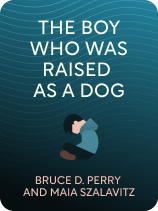

This article is an excerpt from the Shortform book guide to "The Boy Who Was Raised as a Dog" by Bruce D. Perry and Maia Szalavitz. Shortform has the world's best summaries and analyses of books you should be reading.
Like this article? Sign up for a free trial here.
What key points can we take away from Dr. Bruce Perry’s The Boy Who Was Raised as a Dog? What does Perry teach about childhood trauma?
In The Boy Who Was Raised as a Dog, author Dr. Bruce Perry leverages his expertise as a child psychiatrist to teach the fundamentals of how trauma impacts children and how it can be treated. Understanding the key takeaways from this book gives you a foundational understanding of what trauma is and how it works.
Discover how trauma impacts the developing brain and how it can be treated.
About The Boy Who Was Raised as a Dog
In The Boy Who Was Raised as a Dog, child psychiatrist Bruce Perry describes a series of child abuse and neglect cases to illustrate how trauma impacts the developing brain and explain how he and his colleagues established an effective therapy model for traumatized children.
Perry is a psychiatrist and the senior fellow of not-for-profit organization The ChildTrauma Academy. He’s also a professor at the Feinberg School of Medicine in Chicago and co-author (with Oprah Winfrey) of the bestselling book What Happened to You?. Perry’s co-author of The Boy Who Was Raised as a Dog, Maia Szalavitz is an award-winning journalist and author of the books Unbroken Brain and Help at Any Cost. Perry and Szalavitz also co-wrote Born for Love together.
In this article, we’ll explain the psychiatric principles that Perry discovered during his years of working with traumatized children, including the stress response, the effects of trauma in infancy versus trauma at a later age, dissociation in response to trauma, and the role that relationships play in the treatment of traumatized children. We’ll also look at specific case studies that contributed to Perry’s Neurosequential Model of Therapeutics. Our commentary explores research supporting and expanding on Perry’s ideas, as well as scientific and social context on how trauma can manifest and the nuances of treatment.
Understanding Childhood Trauma
According to Perry, the general belief in the 1980s—when he was first entering the field of child psychiatry—was that trauma didn’t impact children as heavily as it impacted adults. Children were seen as resilient; psychiatrists assumed they could recover from trauma quickly and easily. However, Perry’s and other researchers’ work has since shown that trauma impacts children more strongly than it does adults, and that the earlier in life it occurs, the more likely it is to have severe and long-lasting consequences.
The Developing Brain
To understand childhood trauma and its long-term impact, Perry says, we first need to understand how our brain develops in childhood. The brain develops sequentially, starting with the most simple regions, then grows more complex with age. The brainstem develops first, followed by the diencephalon, the limbic system, and finally the cortex.
However, this neural development doesn’t happen automatically. The brain must be stimulated in certain ways and at certain times in order to trigger its growth. In infancy and early childhood, that stimulation comes primarily from caregivers. As we age, we also begin to receive neural stimulation from our interactions with peers and people outside our caregiving circle. Perry explains that neglect can leave the growing brain without this stimulation, while abuse and other traumatizing experiences can change the brain’s responses to such stimulation. This is because this neural stimulation is what teaches us to regulate our brain and body’s stress response, which, as we’ll see in the next section, determines how we cope with traumatizing events.
The Stress Response
Because of its critical role in the experience of trauma, understanding the body’s natural stress response is essential to understanding all the other principles and cases Perry describes. According to Perry, the most primitive parts of our brain control the stress response, which is a physiological reaction that allows us to respond to threats in our environment. Perry describes two types of stress responses: hyperarousal and dissociation.
Hyperarousal prepares the body to flee or fight a threat by flooding it with chemicals like adrenaline and noradrenaline. Dissociation prepares the body to endure physical harm by slowing its major functions and releasing natural opioids to numb pain. Both of these responses also shut down higher-level brain functions, like abstract thinking and impulse control, in favor of functions that are likely to help us survive the current threat.
The Stress Response in Infancy
The caregiver-infant interaction lays the neural foundations for coping with and regulating stress later in life. When we’re infants, explains Perry, every new stimulus is stressful, including things as basic and essential as physical touch or hunger. A vital part of infant development is receiving care that teaches us how to respond to and process these new stimuli (or stressors).
When an infant’s stress response system is activated, it cries—a reaction that’s designed to elicit a response from caregivers who attend to the infant’s needs. For example, if the infant is hungry, the caregiver responds by feeding; if the infant is afraid or uncomfortable, the caregiver soothes them with holding, cooing, and rocking. These behaviors relieve the infant’s stress response by determining the source of the distress and then eliminating it.
According to Perry, this interaction creates an association in the infant’s brain between social interaction with the caregiver and an activation of the reward centers in their brain, resulting in a feeling of pleasure. This association is what makes us enjoy and crave social interaction, and it’s essential for developing empathy (as we’ll discuss later). If the infant doesn’t receive the proper caregiving response, they won’t develop these associations. This can have both immediate and long-term consequences, such as the failure to attach to a caregiver or the inability to relate to others later in life.
The Emotional Consequences of Deprivation in Infancy: Leon’s Case
Because of the connection between the caregiver’s mediation of the infant’s stress response and the infant’s later development, an infant deprived of vital caregiving in early life can have stunted social and emotional development, including a failure to acquire empathy.
As an example of this process, Perry describes the case of a young man named Leon. At age 16, Leon murdered and violated the bodies of two girls. Leon had no remorse for his actions and blamed the girls for sexually tempting him. Perry talked with Leon’s family about his early childhood and discovered that Leon had been severely neglected. His mother Maria, though loving and well-intentioned, had made a habit during Leon’s infancy of leaving the house in the morning and not coming back until the evening, leaving him alone all day.
As a result, his distress signals went unanswered: With no one to provide the care that would relieve his stress response, he never learned to associate human interaction with the relief of distress. He missed out on the neural stimulation that 1) teaches us on a subconscious level that we can rely on others, and 2) makes us feel good when we please others and bad when we’re rejected by them. Thus, Perry says, he was unable to derive pleasure from (or even understand) interpersonal relationships, and he failed to develop social skills and empathy.
The Physical Consequences of Touch Deprivation in Infancy: Laura’s Case
Deprivation of physical stimulation in infancy can also have a major impact on infants’ physical development. As mentioned earlier, physical touch is initially stressful for infants, as it’s a sensation they’re not used to. In order to properly develop their stress response systems and make touch less stressful and ultimately soothing, infants need a great deal of loving physical touch. The stress response has a direct impact on the body’s hormone regulation, so a lack of touch can inhibit the release of growth hormone and stunt physical growth—a condition called “failure to thrive,” or the inability to develop physically despite receiving sufficient calories and nutrients.
This was the case with Laura, a four-year-old who weighed just 26 pounds when Perry met her. (Shortform note: For context, the average weight for a healthy four-year-old is about 40 pounds.) In talking with Laura’s mother Virginia, Perry discovered that the woman had no knowledge or experience of loving, attentive care herself, and she simply didn’t know that she needed to hold her baby during feeding, rock her when she cried, and so on. Laura’s stress response systems weren’t developing properly due to lack of physical touch, and as a result, her body wasn’t producing enough growth hormone, so it couldn’t develop or grow. Once Virginia learned to provide this vital stimulation, Laura began thriving.
Trauma at Later Ages: Associations and the Dissociative Response
These cases demonstrated that stress and trauma in infancy could have long-lasting impacts. Some of Perry’s other cases showed how trauma later in childhood could impact children’s behavior differently. Below, we’ll first explain how the brain stores information, including traumatic experiences. Then we’ll look at the dissociative stress response and how it differs from the hyperarousal response described earlier.
Traumatic Associations: Tina’s Case
Perry explains that the brain stores information in the form of memories and associations. Associations, like those between caregiving and the brain’s reward centers, occur when two neural patterns are activated at the same time again and again, eventually forming a new set of connections between areas of the brain.
To illustrate the role of associations in trauma, Perry describes the case of a young girl named Tina. At the age of seven, she was engaging in sexually inappropriate behaviors with peers and acting out in aggressive ways. She also behaved impulsively and had trouble paying attention in school. Tina’s mother explained her history, and Perry learned that Tina had been sexually abused by a neighbor’s teenage son over the course of two years.
The associations formed in Tina’s brain from this experience caused an automatic stress response when she was around men, and the memory template she had developed based on the traumatic experiences taught her to try to appease them (and thus reduce the threat they posed) with sex. This association is what led her to behave inappropriately even with men who had never preyed on her. Additionally, the constant engagement of her stress response system led her to be on high alert for threats at all times, making it difficult for her to focus on schoolwork and control her impulses.
Perry realized that the model of one hour per week of therapy wasn’t sufficient to undo the ingrained associations that Tina had. In fact, as Perry amended later, therapy can’t undo associations at all. Instead, you have to create new associations that will eventually replace the old ones in guiding the patient’s behavior. You can do this by providing the patient with frequent, repeated experiences to form and strengthen new neural connections. In Tina’s case, her experiences with sexual abuse by a man had formed a harmful association with males, so she needed repeated experiences with safe men in non-sexual contexts to help her form new templates and behave more appropriately.
Dissociation as a Stress Response
In many of the cases Perry describes in which children’s stress response systems become overactive due to excessive stimulation, physiological checks on the children showed that their heart rates were elevated, a sign of the fight or flight response.
However, the body has other ways to respond to stress depending on the situation. In cases where a threat is too great to escape or fight off, the brain may activate a dissociative response—a response particularly common in children, who often lack the physical or mental means to fight or flee from a threat. Dissociation prepares the body to endure physical harm: It slows breathing and reduces blood flow and heart rate, which can help the body avoid bleeding to death, and the brain releases natural opioids that can alleviate pain and help the person detach psychologically from what’s happening to them.
Both hyperarousal and dissociative responses occur on a spectrum: Hyperarousal may look like a slightly elevated heart rate and nervousness or full-blown panic. Dissociation may take the form of daydreaming, or in extreme cases may cause the person to completely detach from reality and withdraw into their own mind. They become calm and numb, time seems to slow, and it feels as if what’s happening to them isn’t real and like they’re watching it happen to someone else. Additionally, these responses rarely occur in complete isolation: Most trauma responses involve a combination of hyperarousal and dissociation.
Treating Childhood Trauma: Perry’s Neurosequential Model of Therapeutics
The model that Perry developed for psychiatric treatment—the Neurosequential Model of Therapeutics—is founded on the premise that neural development must occur in order, and that if a child misses a developmental milestone due to the effects of their environment (such as abuse, neglect, or other trauma), that milestone can’t be “skipped over.” For example, if a child is not spoken to during their early childhood years, they won’t develop the language skills needed to speak or understand others at the same time other children do, and depending on the extent of the deprivation, they may never develop their language faculties at all.
And, since brain development is cumulative, if a milestone is missed, the functions that build on that milestone won’t develop properly either. The brain will still require a specific type of stimulation to develop that foundational function or region. This means that we can’t treat traumatized children based on their chronological age; rather, we must treat them based on their developmental age.
What Does Effective Therapy Look Like?
According to Perry, effective trauma therapy must have certain characteristics: It must involve regular, repeated experiences that build on the patient’s existing skills and target their needs; it must take place in a predictable environment in which the patient feels safe; and it must be patient-directed and voluntary.
Therapists drawing on the Neurosequential Model of Therapeutics progress through the following four steps:
- Understand the patient’s history, including the type of trauma they experienced and when they experienced it, as well as the patient’s relationships with others.
- Understand the patient’s current status, including their strengths, needs, and the quality of their relationships with others.
- Create a treatment plan that builds on the patient’s skills and targets their needs.
- Implement the treatment plan and adjust it as needed.
Children Helping Each Other: Peter’s Case
Perry also explains how children can help each other in their treatment, using the case of Peter, who was born in a Russian orphanage and only received a few minutes of basic interaction per day. As such, he missed out on vital caregiving responses like those described earlier. When he started school in America, he had severe deficits in language and social skills and was prone to long, frightening, and aggressive outbursts.
Peter’s peers feared him and didn’t interact with him, which made things worse. Once Perry visited Peter’s class and explained Peter’s background and why he behaved the way he did, the other children opened up to Peter. They invited him to play, sometimes even arguing over who got to be his partner in class activities. Peter improved rapidly as a result of these supportive relationships, and Perry explains that these children gave him more therapeutic treatment than the adults in his life ever could have.
The Importance of Community
Many of these cases highlight another major point that Perry emphasizes: the importance of community in child-rearing. He explains that humans are extremely social creatures, and because of this, relationships are the most important factor in both facilitating healthy development and healing trauma.

———End of Preview———
Like what you just read? Read the rest of the world's best book summary and analysis of Bruce D. Perry and Maia Szalavitz's "The Boy Who Was Raised as a Dog" at Shortform.
Here's what you'll find in our full The Boy Who Was Raised as a Dog summary:
- How trauma impacts the developing brains of children
- Case studies of child abuse and neglect, as told by a child psychiatrist
- An explanation of the Neurosequential Model of Therapeutics






